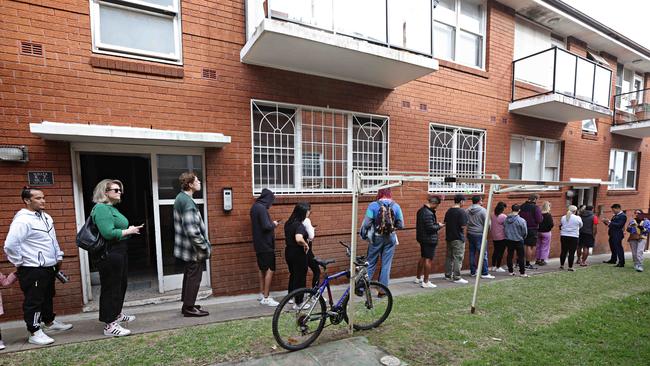Australian rent prices grow 11.5 per cent in 2023, but PropTrack says tide is turning
The rental market is showing signs of cooling, with rents rising at the slowest pace in two years, as cost of living pressures limit growth.

The country’s rental market is showing signs of a moderation, with asking prices rising by the smallest margin annually in nearly two years as cost of living pressure begin to work their way through.
Data from PropTrack shows dwelling rental prices were up 1.8 per cent over the December quarter nationally, with the median rent $580 per week. This brings rents up 11.5 per cent, or $60 per week, compared to a year ago.
In capital cities the rental growth was lower at 0.8 per cent for the quarter and 13.2 per cent annually with a median dwelling rent of $600 per week.
The rental market has been marred by record low vacancy rates and a shortage of new home builds at the same time the population rose by half a million people in the past year.
But with rents seeing the slowest pace of annual growth since early 2022, PropTrack economist Angus Moore said while it may be welcome news it would not be widespread relief.
“There are some signs that rent growth may be slowing, and some relief on the horizon,” he said.
“It is still very challenging for renters and even though there is some relief on the horizon, it won’t be in the immediate term, with rents still growing strongly.”
Record low vacancy rates have seen tenants resort to rent bidding where much more than the asking price is offered in a bid to secure a property, but Mr Moore said inflation and cost of living pressures were now having an impact on how high prices could rise.
“The rents we’ve seen over the past few years were always going to be a strain on affordability,” he aid.
“And that will start to slow down rent growth. At some point, there’s only so much people can pay and that will start to act as a break on how much further rents can run.”
He added prices were expected to keep rising for at least the next six months with a growing number of investors likely to bring more supply from the later stages of 2024.
Rents have been a key driver for inflation, with the sector recording its largest annual growth since 2009 of 7.6 per cent annually compared to the current inflation reading of 5.4 per cent, according to the Australian Bureau of Statistics.

Sydney was the most expensive city in Australia with apartments helping the median dwelling rent rise 1.4 per cent in the quarter and annually 16.7 per cent to $750 per week. The ACT was the next most expensive, followed by Brisbane.
Melbourne was the cheapest city in the country with rents at $550 for houses and $520 for units as it attempted to recover from price falls in 2020 and 2021 caused by Covid-19 lockdowns. It however saw the strongest growth in the quarter with dwelling increases up 3.8 per cent
“Melbourne hasn’t caught back up from that period. It is relatively affordable and is catching up to some of the other cities from that sort of sluggish period during the pandemic, but it does remain relatively affordable by comparison,” Mr Moore said.
The West Australian capital of Perth saw the fastest rent growth over the past year — reflecting its incredibly low rental vacancy rate — the second tightest behind Adelaide.
Perth, which has seen rents surge 20 per cent in the past year for dwellings to $600 per week, has seen rapid growth for a number of years, and median advertised rents are now up 66 per cent compared to pre-pandemic.

Mr Moore said Perth had seen strong growth after a fairly soft decade following the mining boom between 2008 and 2010, and was catching up for lost time.
“It’s seen quite strong housing markets and part of that is actually just the fact that the decade prior was fairly soft,” he said.
“Perth looks, relatively, a bit more affordable today than it did. And so part of that is why we’re seeing really strong growth now, both in home prices and in rents.”
January is considered the busiest time of the year for the rental market as people look to move and settle before the start of the school year.




To join the conversation, please log in. Don't have an account? Register
Join the conversation, you are commenting as Logout